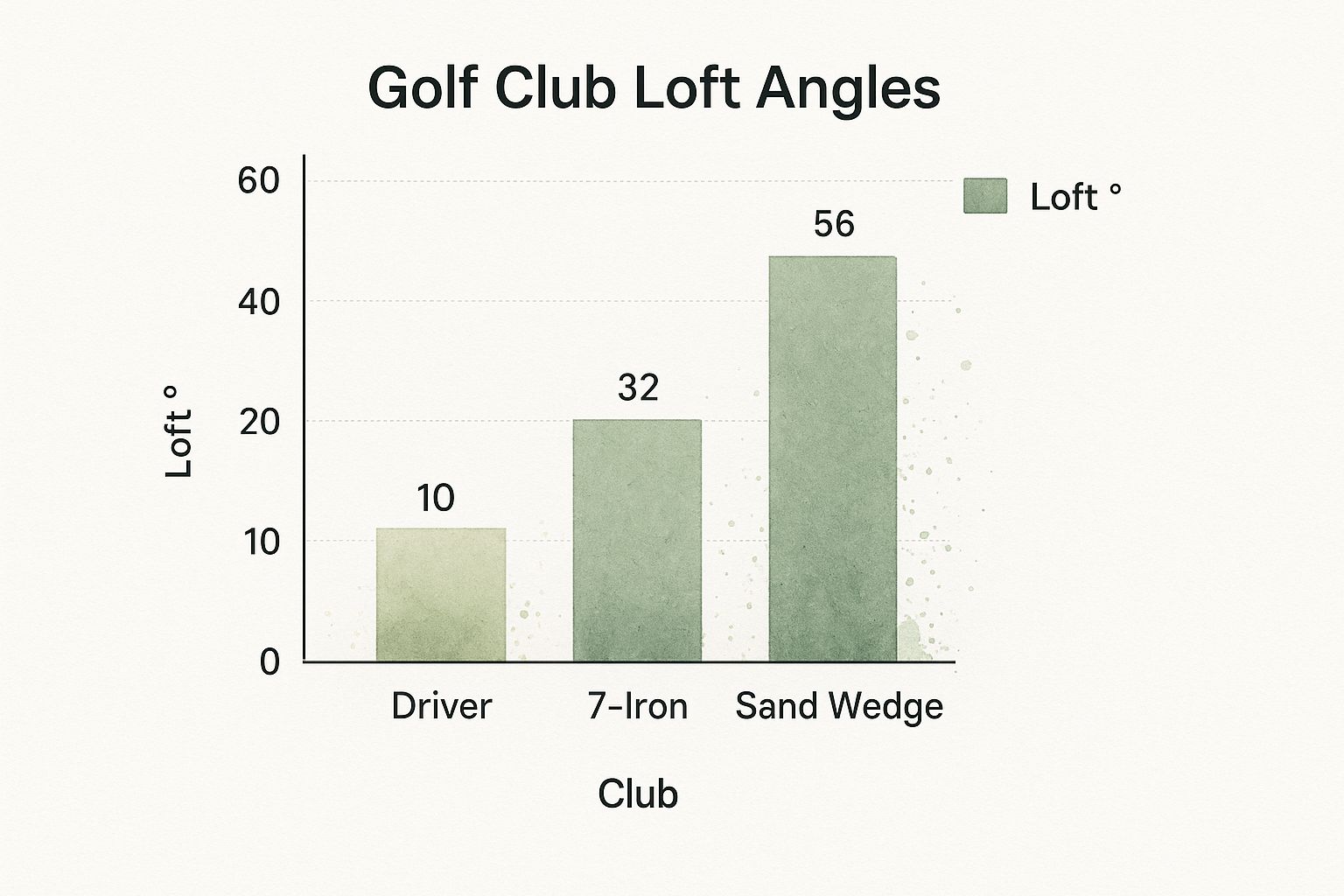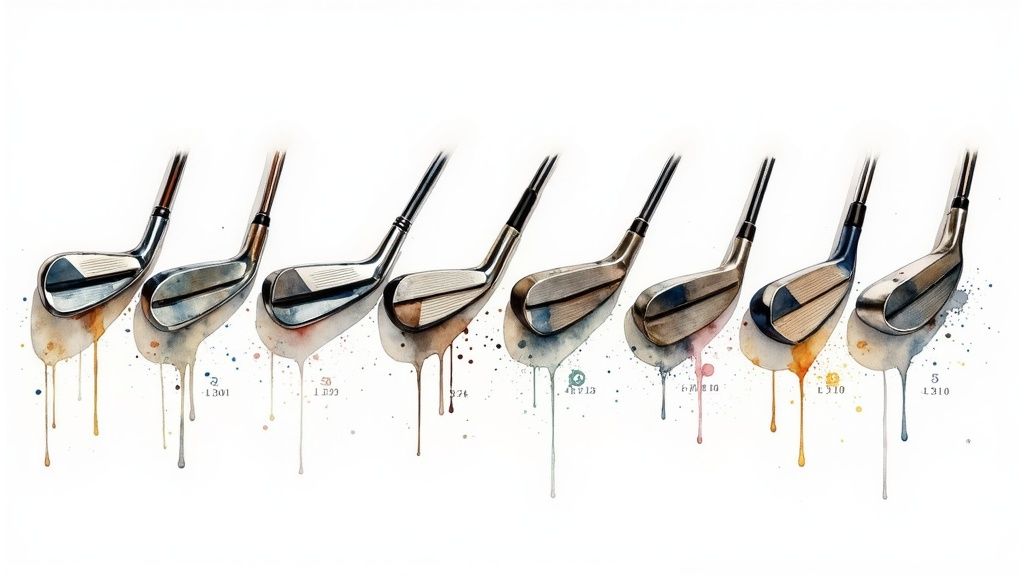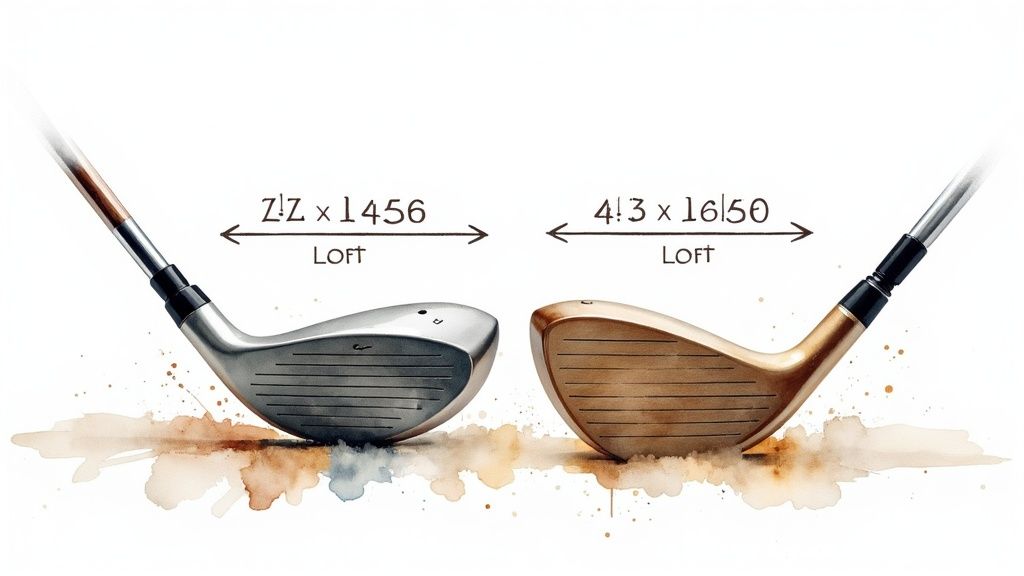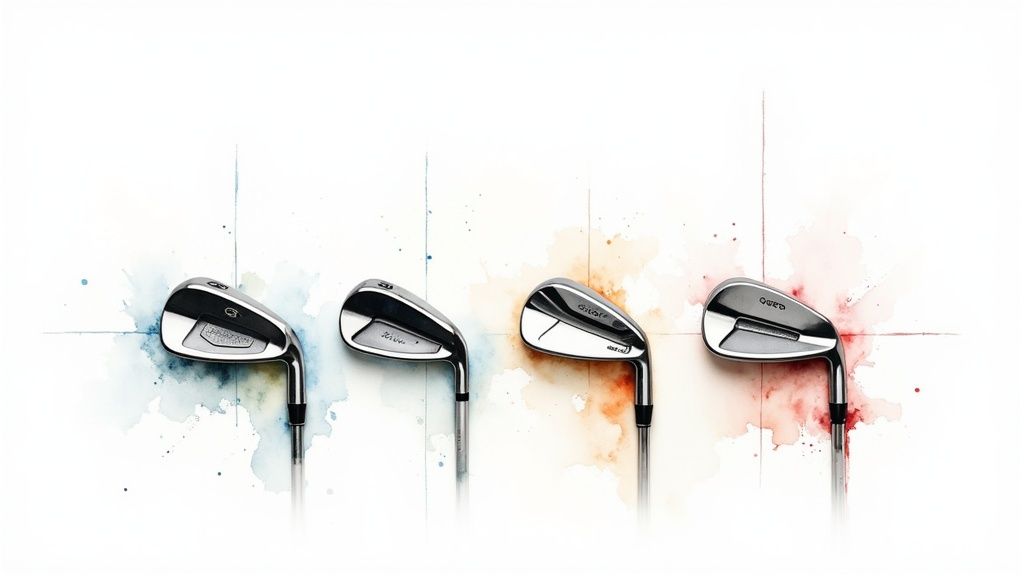When you first look at a degrees of golf clubs chart, a simple truth jumps out: lower loft means more distance, while higher loft creates more height and spin for control. Think about your driver—it has a very low loft (around 9-12 degrees) to send the ball screaming down the fairway. On the flip side, your sand wedge has a high loft (around 54-58 degrees) designed to pop the ball up and out of a bunker with almost no roll. The degrees of golf clubs chart is a valuable resource for strategizing your play.
Decoding Golf Club Lofts
Getting a handle on the degrees of golf clubs is one of the most important steps to improving your game and making smarter choices on the course. Every club in your bag has a specific loft—the angle of the clubface in relation to the shaft—which is the main ingredient in the recipe for how high and far the ball will fly. This angle is what makes your driver a cannon and your lob wedge a scalpel. The degrees of golf clubs chart serves as a foundational guideline for making informed decisions.
Understanding this concept helps you build a well-gapped set, making sure you have the right tool for any distance you face. Think of it like a mechanic’s toolkit; you wouldn’t use a hammer to turn a screw. Knowing what each club’s loft is designed to do keeps you from grabbing the wrong tool for the shot. For optimal performance, ensure you’re familiar with the degrees of golf clubs chart.
This infographic gives you a quick visual of the average loft angles for a few key clubs you’ll find in almost any golf bag.

As you can see, the loft increases dramatically from the distance-focused driver to the precision-oriented sand wedge. This progression is the secret sauce of club design and is exactly what gives you control over your ball flight and overall shot-making strategy.
Standard Golf Club Loft Degrees at a Glance
For a quick reference, here’s a table that breaks down the typical loft ranges for every club category. It’s a great way to see how the lofts flow from one club to the next and spot any potential gaps in your own set.
| Club Category | Club Name or Number | Typical Loft Range (Degrees) |
|---|---|---|
| Woods | Driver | 9 – 13 |
| Woods | 3-Wood | 15 – 18 |
| Woods | 5-Wood | 18 – 21 |
| Irons | 3-Iron | 20 – 22 |
| Irons | 4-Iron | 22 – 25 |
| Irons | 5-Iron | 25 – 28 |
| Irons | 6-Iron | 28 – 32 |
| Irons | 7-Iron | 32 – 36 |
| Irons | 8-Iron | 36 – 40 |
| Irons | 9-Iron | 40 – 44 |
| Wedges | Pitching Wedge (PW) | 44 – 48 |
| Wedges | Gap Wedge (GW) | 50 – 53 |
| Wedges | Sand Wedge (SW) | 54 – 58 |
| Wedges | Lob Wedge (LW) | 58 – 62 |
Keep in mind these are just typical ranges. Manufacturers often have slightly different “strong” or “weak” lofts depending on the model and whether it’s built for distance or feel. It’s always a smart move to check the specs for your specific clubs.
What Golf Club Loft Means for Your Game

Before we jump into a full-blown degrees of golf clubs chart, let’s get a handle on what loft actually is. Simply put, loft is the angle of the clubface relative to a perfectly vertical shaft. This one number is the single biggest factor determining how your ball flies through the air.
I like to think of it like the nozzle on a garden hose. When you want a powerful stream to reach the other side of the yard, you tighten the nozzle for a laser beam of water. That’s your low-lofted driver. When you want a soft, high spray for the delicate flowers right in front of you, you open it up. That’s your high-lofted wedge. Loft is what lets you dial in the shot.
How Loft Controls Trajectory and Spin in Golf
The degree of loft directly impacts what the golf ball does the moment it leaves the clubface—specifically its trajectory and spin. A club with a lower loft angle is going to produce a lower, more piercing flight with less backspin, meaning the ball will roll out more when it lands. A typical degrees of golf clubs chart will illustrate the loft range for each type of club.
On the other hand, a higher loft angle sends the ball soaring up with tons of backspin. That’s what allows the ball to land softly and stop on a dime, just like you see the pros do.
Let’s break it down in practical terms:
- Low Loft (Driver, 3-Wood): These clubs are built for a lower launch and minimal spin. They’re your go-to for getting maximum total distance off the tee.
- High Loft (Sand Wedge, Lob Wedge): These produce a very high launch and a ton of spin. They are absolutely perfect for approach shots where you need the ball to land and stick to the green like glue.
The rule of thumb is simple: more loft equals more height and more spin. Less loft gives you more distance and more roll. Grasping this concept is what allows you to look at a yardage and pick the right tool for the job with confidence.
Once you understand this relationship, the numbers on a loft chart stop being just numbers. They become real, actionable information you can use to make smarter decisions on the course and, ultimately, shoot lower scores. Every club selection you make, from a huge drive to a tiny chip, hinges on this principle.
Understanding Lofts: Drivers, Woods, and Hybrids in Golf

When you absolutely need to crush the ball down the fairway, you reach for the big guns. These are your longest clubs—the driver, fairway woods, and hybrids—and they’re all about blending power with just enough precision. Each one is a low-lofted engine designed for one thing: distance. Getting a handle on their specific lofts is your first step to mastering the long game.
The driver is, without a doubt, the king of the tee box. It has the lowest loft of any club in the bag, usually between 8 and 12 degrees. That minimal angle is specifically engineered to create a high launch with low spin, which is the magic formula for maximum carry and roll. A player with a blistering swing speed might lean toward a lower loft (8-9.5°) to keep spin down, but most of us weekend warriors will see better results from a higher loft (10.5° or more) to get the ball airborne more easily.
Right behind the driver, you have your fairway woods and hybrids. These clubs are absolutely critical for bridging the gap between your tee shots and your iron play.
Golf: Fairway Woods and Hybrids
Fairway woods, like the trusty 3-wood (15-18°) and 5-wood (18-21°), give you that perfect blend of raw distance and playable control. Their design makes them much easier to hit off the deck than a driver, making them your go-to for long second shots or for finding the fairway on tight tee shots where accuracy is everything.
Hybrids have been a total game-changer for so many golfers, and for good reason. They take the forgiving nature of a wood and pack it into the playable shape of an iron. Hybrids are numbered to take the place of their long-iron counterparts, which, let’s be honest, most amateurs struggle to hit well.
- 3-Hybrid (19-21°): This is the perfect replacement for a traditional 3-iron. It’s a fantastic club for getting out of thick rough or for hitting high, soft-landing shots into greens from way out.
- 4-Hybrid (22-24°): A truly versatile club that takes the place of a 4-iron. It offers a ton more forgiveness and a much higher ball flight than the iron it replaces.
The demand for these specialized clubs isn’t just in our heads; it shows just how much the game is growing. The global golf club market was valued at around $4,374.5 million and is expected to hit $5,453.6 million by 2032.
Ultimately, picking between these types of golf clubs comes down to the shot in front of you. A 3-wood might be the smart play off the tee on a skinny par-4, but that hybrid will feel like your best friend when you need to pull off a long recovery shot.
Mastering Your Golf Irons from Long to Short
While woods and hybrids are your power hitters, the irons are the heart and soul of your golf bag. Think of them as your precision tools, built for accuracy and consistency. Getting a handle on the loft of each iron is absolutely critical if you want to start hitting more greens and watching your scores drop.
Irons are usually broken down into three simple categories: long, mid, and short. This isn’t just jargon; it’s a practical way to think about club selection out on the course. It helps you grab the right tool for the exact yardage and shot shape you’re facing. These are your scoring clubs from the fairway.
Long Golf Irons for Approach Shots
Your long irons—the 2-iron (18-20°), 3-iron (20-22°), and 4-iron (22-25°)—are designed for those long approach shots into par-5s or for finding the fairway on tight par-4s. They have the lowest lofts of any iron, which creates a lower, piercing ball flight that runs out a fair bit after landing.
But let’s be honest, their low loft makes them notoriously tough for most amateur golfers to hit well. It’s exactly why hybrids have become so popular; they offer a much more forgiving way to cover those same distances.
Mid Golf Irons: Your Go-To Clubs
This is where you’ll do most of your work. The mid-irons—your 5-iron (25-28°), 6-iron (28-32°), and 7-iron (32-36°)—are the real workhorses in your bag. You’ll pull these for a huge range of approach shots, from medium-length par-3s to your second shot on most par-4s.
Their lofts strike a perfect balance between distance and control. They launch the ball high enough to hold the green but still give you plenty of yardage to work with. For any golfer looking to get better, mastering the mid-irons is a huge milestone.
Short Golf Irons for Precision
When you’re in scoring range, it’s time for the short irons: the 8-iron (36-40°) and 9-iron (40-44°). These clubs have more loft, which is designed to produce a high, soft-landing shot with a ton of spin. That control is what lets you attack pins with confidence, knowing the ball will stop on a dime.
This is where the concept of loft gapping becomes so important. A well-designed set of irons will have a consistent loft gap of about 3-4 degrees between each club. This should translate to a reliable 10-15 yard distance gap. If your gapping is off, you’ll constantly find yourself stuck between clubs. Leverage the degrees of golf clubs chart to enhance your understanding and enjoyment of the sport.
The focus on high-performance irons is a huge part of the market. In fact, golf clubs accounted for nearly 38.84% of the golf equipment industry, driven by players looking for an edge. You can see more on these trends in the golf equipment industry report from Mordor Intelligence.
Understanding the Finesse of Your Golf Wedges

As you get closer to the pin, raw power gives way to surgical precision. This is wedge territory, where your scoring clubs truly shine. Getting a handle on the specific lofts of your wedges is the secret to a deadly short game, turning tough spots around the green into genuine birdie chances.
These clubs have the highest lofts in your bag for a reason: they’re built to launch the ball high and land it softly, stopping it dead in its tracks. Each wedge has a distinct job, and a complete degrees of golf clubs chart highlights the big loft jumps between them, giving you a full arsenal for any shot inside 100 yards. Be sure to reference the degrees of golf clubs chart when considering new club purchases.
The Golf Wedge Family Breakdown
A well-rounded bag usually features four key wedges, each designed for specific situations you’ll face around the green.
-
Pitching Wedge (PW): Clocking in between 44-48 degrees, the PW is your lowest-lofted wedge. It’s the go-to for those longer approach shots that need to stick the green and for controlled chip shots that require a bit of roll-out. If you really want to dive deep, we’ve got a full guide on what degree a pitching wedge is.
-
Gap Wedge (GW): Often called an Approach Wedge (AW), this club’s loft sits right around 50-53 degrees. Its name says it all: it perfectly “fills the gap” in yardage between your Pitching Wedge and Sand Wedge on full swings.
-
Sand Wedge (SW): With a loft between 54-58 degrees, the SW is your best friend in the bunker. That high loft, combined with a feature called bounce, helps the club knife through the sand and pop the ball out cleanly.
-
Lob Wedge (LW): This is your specialty tool, boasting the highest loft in the bag at 58-62+ degrees. It’s designed for those high, soft flop shots you need to pull off when you’re short-sided or have to clear a hazard with very little green to work with.
Pro Tip: Don’t just look at loft; you have to consider a wedge’s bounce, too. That’s the angle on the club’s sole. A high-bounce sand wedge is a lifesaver in soft, fluffy sand, while a low-bounce lob wedge is better for nipping the ball cleanly off tight lies.
How Modern Golf Club Designs Impact Loft
If you’ve ever smashed a brand-new 7-iron and watched it sail as far as your old 5-iron, you’re not going crazy. This isn’t just a feeling; it’s a huge trend in modern golf equipment called strengthened lofts. Club manufacturers, especially in the game-improvement category, are designing irons with lower loft angles than they used to.
The reason is simple: to sell you more distance. A modern 7-iron might have a loft between 28-31 degrees, which is squarely in the territory of a traditional 5-iron. This lets manufacturers market clubs that help everyday golfers hit the ball farther—a promise that’s tough for many of us to resist.
Why Stronger Lofts Matter to You in Golf
This shift completely changes how you should think about building your set and picking a club on the course. It basically makes the number stamped on the bottom of the club a bit of a guess. You could have two 7-irons from different manufacturers with lofts that are several degrees apart, leading to massive, unexpected distance gaps in your bag.
Because of this, comparing clubs just by their number is an outdated way of thinking. To build a bag that performs consistently, you have to dig into the actual specs.
It’s crucial to know the precise loft of each iron in your bag. This knowledge allows you to build a set with consistent yardage gaps, ensuring you have a reliable club for every distance you face on the course.
The explosion in golf’s popularity has only pushed this trend forward, with a highly competitive industry adapting to what players want. In the U.S. alone, the market for Golf Courses & Country Clubs was recently valued at a whopping $34.8 billion. This huge market fuels the competition among manufacturers to create clubs that deliver better performance for the average player. You can get more details from this overview of the U.S. golf industry market size.
Ultimately, understanding loft strengthening helps you make smarter choices when buying clubs. Instead of getting hung up on the club number, check out the degrees of golf clubs chart from the manufacturer. This ensures you’re buying a set that actually fits your game and gives you predictable gapping from your longest iron down to your shortest wedge. Incorporating insights from the degrees of golf clubs chart into your game can yield impressive results.
Even with a detailed chart in hand, a few common questions always seem to pop up. Let’s tackle some of the most frequent queries golfers have about lofts, so you can apply this knowledge directly to your own bag. Understanding the degrees of golf clubs chart is essential for golfers of all skill levels. It helps in selecting the right club for various situations on the course.
FAQ’S
What Is a Standard Loft for a 7-Iron?
The short answer? There’s no longer a “standard” loft for a 7-iron. Back in the day, you could count on a 7-iron having around 34-36 degrees of loft, but that’s completely changed with modern club technology.
Today’s game-improvement irons often feature much stronger lofts, sometimes as low as 28-31 degrees. Manufacturers do this to help you hit the ball farther. This “loft jacking” means a new 7-iron from one brand might fly as far as a 6-iron from another. It’s absolutely crucial to check the specific specs for your set to know what you’re actually playing.
How Many Degrees of Loft Should Be Between Each Club?
For your irons, the sweet spot is a gap of 3 to 4 degrees of loft between each club. This consistency is what creates predictable yardage gaps, usually around 10-15 yards from one iron to the next, which is the key to accurate approach shots.
When you get to your wedges, you have a bit more flexibility. A wider gap of 4 to 6 degrees between your pitching, gap, sand, and lob wedges is pretty common. This gives you more versatility for all the different shots you need around the green, from full swings to delicate chips and bunker shots.
Having consistent loft gaps is the foundation of a well-built bag. It eliminates those frustrating moments when you find yourself stuck between two clubs, unsure of which one to hit for a specific yardage.
Does My Swing Speed Affect the Loft I Should Use?
Absolutely. Swing speed is a huge factor in getting the most out of your clubs, especially the driver. The whole goal is to optimize your launch conditions—getting a high launch with low spin—to squeeze every last yard out of your tee shot.
Here’s a general guide:
Slower Swing Speeds (Below 90 mph): If this is you, a higher-lofted driver (10.5 degrees or more) will likely be your best friend. That extra loft helps get the ball up in the air more easily, which maximizes your carry distance.
Faster Swing Speeds (Above 105 mph): Players with faster swings often need less loft to keep the ball from flying too high and losing distance. A driver with 8 to 9.5 degrees of loft can help control spin and prevent the ball from “ballooning.”
At Golf Inquirer, we believe that understanding your equipment is the first step toward playing better golf. For more tips, gear reviews, and guides to help you master the green, visit us at https://golfinquirer.com.



